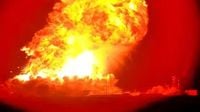On the night of June 18, 2025, SpaceX's Starship 36 rocket exploded in a dramatic fireball during a routine static fire test at the company's Starbase facility in Texas, marking another significant setback for Elon Musk's ambitious space exploration program. The explosion occurred around 11 PM local time as the rocket was undergoing a critical pre-flight procedure designed to ignite its engines while firmly bolted to the launch mount, ensuring systems were functioning before an actual launch.
Footage of the incident quickly went viral, capturing the moment the nose of the Starship suddenly burst open, producing a blinding white flash followed by a massive ball of fire that engulfed the base of the rocket. Thick black smoke billowed into the night sky, and the explosion was powerful enough to shake windows and rattle dishes in nearby Cameron County, startling local residents.
SpaceX promptly issued a statement confirming the rocket suffered "a major anomaly while on a test stand at Starbase," reassuring the public that a safety clear area had been maintained throughout the operation and that all personnel were safe and accounted for. The company emphasized that there were "no hazards to residents in surrounding communities" and urged people not to approach the site as their Starbase team worked alongside local officials to secure the test area.
The Cameron County Sheriff's Office verified the explosion, and firefighters were dispatched to the scene. Meanwhile, the City of Port Isabel informed residents about the "spacecraft anomaly" and encouraged anyone who experienced damage to report it through official channels.
This incident adds to a series of high-profile failures for SpaceX's Starship program in 2025. Earlier this year, two consecutive test flights ended in explosions shortly after launch—one disintegrating over the Caribbean and another breaking apart over the Atlantic Ocean. In a more recent test, a 403-foot Starship exploded over the Indian Ocean during a mission to deploy Starlink satellite simulators and test the vehicle's reentry system, which involved removing a significant number of heat-shield tiles. The Super Heavy booster suffered a catastrophic failure during splashdown, an outcome SpaceX had anticipated given the extreme test conditions.
Even the 35th iteration of the Starship rocket faced a fiery fate during a static fire test in May 2025 when debris was ejected from the flame trench beneath the launchpad. These setbacks highlight the technical challenges SpaceX faces in developing the world's largest and most powerful rocket system, designed to be fully reusable and capable of carrying humans and cargo to the Moon, Mars, and beyond.
Despite these repeated failures, SpaceX and Elon Musk remain committed to rapid iteration and development. The company views each test, successful or not, as an opportunity to gather vital data to improve the Starship's reliability. "With a test like this, success comes from what we learn, and today's test will help us improve Starship's reliability as SpaceX seeks to make life multi-planetary," SpaceX stated after the May test.
Elon Musk has indicated an aggressive timeline for upcoming flights, promising a faster launch cadence of approximately one flight every three to four weeks. However, the recent explosion at Starbase has forced SpaceX to suspend all launch preparations indefinitely as engineers and federal regulators, including the Federal Aviation Administration (FAA), investigate the cause and assess safety protocols.
The FAA has a history of grounding the Starship program following prior mishaps, requiring SpaceX to identify failure causes and implement corrective measures before resuming flights. Airspace restrictions and debris response protocols have been enforced to ensure public safety, especially given the widespread impact of earlier explosions.
SpaceX's Starship system remains central to Musk's vision of making humanity a multiplanetary species. The fully reusable Starship-Super Heavy rocket is designed to carry massive payloads and eventually human crews beyond Earth's orbit, with plans for lunar missions and voyages to Mars. Achieving these goals, however, demands overcoming significant engineering hurdles, particularly concerning upper-stage reliability during high-stress phases such as engine relights and atmospheric reentry.
For now, the path forward involves meticulous analysis of the latest failure, collaboration with local authorities to secure the test site, and continued refinement of the Starship design. While no injuries have been reported from the recent explosion, the event has delayed upcoming launches and intensified scrutiny of SpaceX's testing procedures.
As SpaceX pushes the boundaries of aerospace innovation, the risks inherent in pioneering new technologies are starkly evident. Yet, the company's commitment to learning from failure and advancing rapid development underscores a belief that these challenges are stepping stones toward revolutionizing space travel and expanding humanity's reach into the cosmos.






